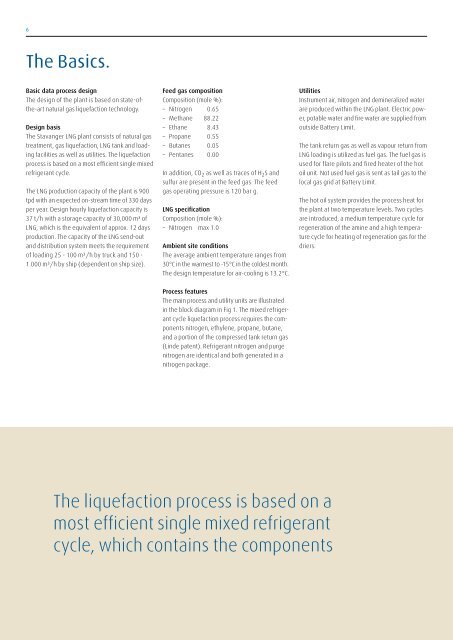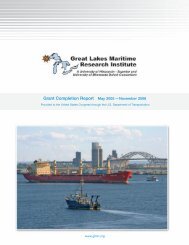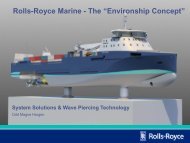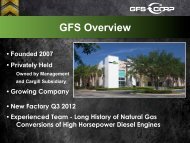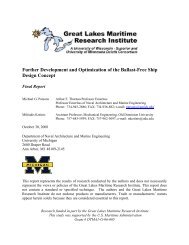Baseload LNG Production in Stavanger - Linde Engineering
Baseload LNG Production in Stavanger - Linde Engineering
Baseload LNG Production in Stavanger - Linde Engineering
You also want an ePaper? Increase the reach of your titles
YUMPU automatically turns print PDFs into web optimized ePapers that Google loves.
6<br />
The Basics.<br />
Basic data process design<br />
The design of the plant is based on state-ofthe-art<br />
natural gas liquefaction technology.<br />
Design basis<br />
The <strong>Stavanger</strong> <strong>LNG</strong> plant consists of natural gas<br />
treatment, gas liquefaction, <strong>LNG</strong> tank and load<strong>in</strong>g<br />
facilities as well as utilities. The liquefaction<br />
process is based on a most efficient s<strong>in</strong>gle mixed<br />
refrigerant cycle.<br />
The <strong>LNG</strong> production capacity of the plant is 900<br />
tpd with an expected on-stream time of 330 days<br />
per year. Design hourly liquefaction capacity is<br />
37 t/h with a storage capacity of 30,000 m³ of<br />
<strong>LNG</strong>, which is the equivalent of approx. 12 days<br />
production. The capacity of the <strong>LNG</strong> send-out<br />
and distribution system meets the requirement<br />
of load<strong>in</strong>g 25 - 100 m³/h by truck and 150 -<br />
1.000 m³/h by ship (dependent on ship size).<br />
Feed gas composition<br />
Composition (mole %):<br />
– Nitrogen 0.65<br />
– Methane 88.22<br />
– Ethane 8.43<br />
– Propane 0.55<br />
– Butanes 0.05<br />
– Pentanes 0.00<br />
In addition, CO 2 as well as traces of H 2 S and<br />
sulfur are present <strong>in</strong> the feed gas. The feed<br />
gas operat<strong>in</strong>g pressure is 120 bar g.<br />
<strong>LNG</strong> specification<br />
Composition (mole %):<br />
– Nitrogen max 1.0<br />
Ambient site conditions<br />
The average ambient temperature ranges from<br />
30°C <strong>in</strong> the warmest to -15°C <strong>in</strong> the coldest month.<br />
The design temperature for air-cool<strong>in</strong>g is 13.2°C.<br />
Utilities<br />
Instrument air, nitrogen and dem<strong>in</strong>eralized water<br />
are produced with<strong>in</strong> the <strong>LNG</strong> plant. Electric power,<br />
potable water and fire water are supplied from<br />
outside Battery Limit.<br />
The tank return gas as well as vapour return from<br />
<strong>LNG</strong> load<strong>in</strong>g is utilized as fuel gas. The fuel gas is<br />
used for flare pilots and fired heater of the hot<br />
oil unit. Not used fuel gas is sent as tail gas to the<br />
local gas grid at Battery Limit.<br />
The hot oil system provides the process heat for<br />
the plant at two temperature levels. Two cycles<br />
are <strong>in</strong>troduced, a medium temperature cycle for<br />
regeneration of the am<strong>in</strong>e and a high temperature<br />
cycle for heat<strong>in</strong>g of regeneration gas for the<br />
driers.<br />
Process features<br />
The ma<strong>in</strong> process and utility units are illustrated<br />
<strong>in</strong> the block diagram <strong>in</strong> Fig 1. The mixed refrigerant<br />
cycle liquefaction process requires the components<br />
nitrogen, ethylene, propane, butane,<br />
and a portion of the compressed tank return gas<br />
(L<strong>in</strong>de patent). Refrigerant nitrogen and purge<br />
nitrogen are identical and both generated <strong>in</strong> a<br />
nitrogen package.<br />
The liquefaction process is based on a<br />
most efficient s<strong>in</strong>gle mixed refrigerant<br />
cycle, which conta<strong>in</strong>s the components


